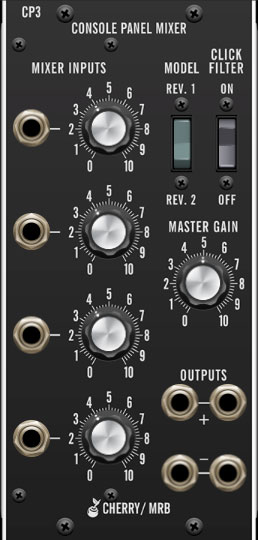The VM900 CP3 is a recreation of the classic modular "Console Panel Mixer." At high inputs levels, it had a tendency to clip the tops and bottoms of waveforms for a characteristic overdriven tone. We've also included a switch that allows selection between the more overdriven tone and the later, cleaner-sounding version.
Note that CP3 is DC-coupled and can be used to mix audio or sub-audio CV signals.
Inputs, Outputs, and Controls
The four inputs are stacked vertically on the left side of the panel; we'll go over the repeated controls just once.
Mixer Inputs jacks and level knobs- Plug inputs into the jacks and set volumes with the knobs. Signals will tend to clip at higher input levels, particularly when the Model switch is set to the Rev. 1 position.
Model- Selects the audio characteristics of the earlier or later production CP3 circuit. Rev. 1 has more of a tendency to clip waveforms, whereas Rev. 2 is less inclined to break up.
Click Filter- When engaged, this rounds of sharp waveform edges to reduce clicking - it's intended for use with edgy control signals to reduce clicking when patched to something such as a VCA CV. The Click Filter is generally not recommended for use with audio signals.
Master Gain- Sets overall output volume. While turning up the four input levels will increase distortion (especially in rev1), Master Gain is pure output gain and has no effect on distortion.
+/- Output jacks - Signal outputs for positive and inverted mixed signals. The (-) out, in addition to being inverted from the (+) out, does not sound the same in Rev. 1 mode - the distortion characteristics are very different between the two jacks. In fact, the outputs are so different that there is quite a stereo image to be had between them. Rev. 2 mode is purely clean and does not exhibit these quirks.
